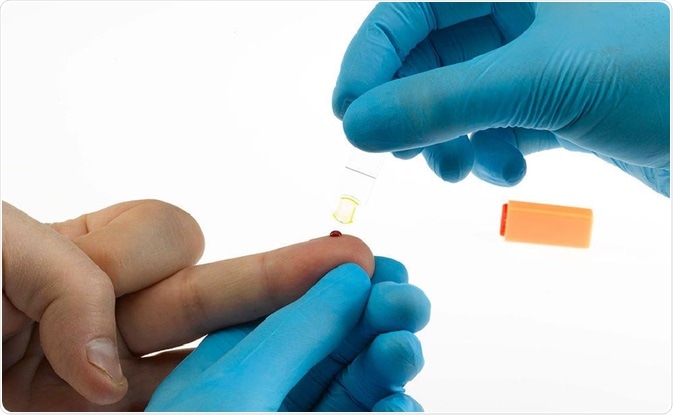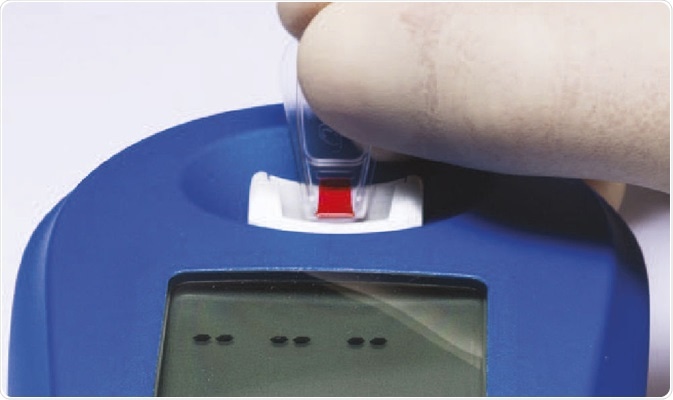Technological advancements in haemoglobin testing methods have resulted in ground-breaking techniques and devices that help in the measurement of haemoglobin concentration in patients.

Image Credit: EKF Diagnostics
For example, an automated haemoglobin analyser allows for reliable, fast, and accurate results in the realm of haematology. A haemoglobin test may depend on a variety of methods, of which some use reagents while others apply “reagent-less” or non-invasive techniques.
Haemoglobincyanide (HiCN) method
The HiCN method of haemoglobin measurement is be done using the principle of haemoglobin conversion to cyanmethemoglobin, where both potassium cyanide and ferricyanide are added.
The availability of an internationally accepted reference standard calibrator1 is one benefit of this type of haemoglobin testing method. Although the HiCN method is still routinely employed in clinics especially in developing countries, cyanide-dependent protocol makes it more commonly used as a reference for the calibration of point-of-care (POC) haemoglobin analysers. Moreover, the HiCN method is a time-consuming and manual process.
Vanzetti's azide methaemoglobin
Using potassium ferricyanide, the conversion of haemoglobin to a coloured and stable azide methaemoglobin is the basis of Vanzetti’s azide methaemoglobin method.2 The azide methemoglobin has almost the same absorbance spectrum as that of HiCN.
Here, a similar reagent employed in the HiCN reference method is used, except sodium azide is used instead of potassium cyanide. This haemoglobin testing method demonstrates high sensitivity and specificity.3
The EKF Hemo Control and the HemoCue® 201 are haemoglobin measurement devices that work on a modification of Vanzetti’s technique. In this method, blood is first pulled into a dry reagent cuvette by capillary action and, then the reagent subsequently destroys the walls of red blood cells.
Following this, free haemoglobin is oxidized to methaemoglobin and ultimately converted to azide methaemoglobin. A main challenge in this method is the sensitivity of the reagent to humidity.
“Reagent-less” methods
POC devices featuring “reagent-less” cuvettes have been developed recently because of the limitations of reagent-based cuvettes. The first POC device to have this feature was the HemoCue® 301, which measures the absorbance of whole blood at 506 nm and the detection of oxygenated and deoxygenated haemoglobin, at 880 nm compensated for turbidity.
DiaSpect, an EKF Diagnostics company, has now pioneered a new technology based on broad spectrum photometry that quantifies haemoglobin without using any reagent. The advanced DiaSpect technology emits a white LED light through a sample to an optical sensor element.

Image Credit: EKF Diagnostics
This sensor element detects absorbance spectra of the blood at a broad wavelength range, which provides a better understanding about the entire absorbance spectrum and results in a higher specificity and a lower sensitivity to interferences.
“Reagent-less” Diaspect cuvettes have a total shelf-life of 2.5 years from production and come with an extensive durability. Another benefit provided by this device is the fast measurement time, which is just about one second.
Non-invasive methods
Following new technological developments, non-invasive methods started being used for detecting the haemoglobin concentration, initially as monitoring tools during surgery and more recently in Point-of-Care and blood donation settings.
There are non-invasive devices that depend on white light as well as the capturing of transmission data to determine the concentrations of haemoglobin in tissue capillaries, while others operate based on pulse oximetry.
As another non-invasive measurement technology, occlusion spectroscopy, features a ring-shaped sensor that is connected to the subject’s finger.5 The sensor momentarily stops the blood flow and triggers an optical signal, which, in turn, produces a high signal-to-noise ratio. This gives an estimation of haemoglobin concentration.
Sahli's method
Sahli’s haemoglobinometer is a manual set of instruments including a pipette, haemoglobin tube, stirrer, and a comparator. Haemoglobin is converted to acid haematin by hydrochloric acid, before the acid haematin is diluted until the solution’s colour matches the comparator block.
This allows the clinician to determine the concentration of haemoglobin by simply reading from the calibration tube. The method is relatively easy, inexpensive, and is often used to assess haemoglobin concentration in resource poor countries, but it does not always provide precise results. For instance, there is inter-observer variability and manual pipetting leads to inaccurate results.3
Haematology analyser
Generally, an automated haematology or haemoglobin analyser helps provide high throughputs to study a range of white and red blood cells as well as haemoglobin and haematocrit levels from the blood sample. A higher precision and quicker results can be achieved when compared to manual techniques.
However, the initial cost of an automated analyser is high and the cost is further increased through the need for stable climate conditions and laboratory personnel for the device as well as regular maintenance. This makes it impractical for use outside the laboratory which is often required when testing haemoglobin, especially in blood donation or anaemia screening settings.
Blood gas analyser (BGA)
BGAs usually use arterial blood to determine a combination of electrolytes, pH, blood gas, and metabolite parameters. Although BGAs may also be used in certain laboratories for haemoglobin testing, they are mostly used in emergency rooms, critical care units, and delivery wards.
The use of BGAs has been simplified during the past years with the introduction of ready-to-use sensor and solution cassettes featuring automated calibrations but maintenance is still required. Recently, hand-held devices with single use cartridges have become available as well.
References
- Shah VB, Shah BS, Puranik GV. Evaluation of non-cyanide methods for haemoglobin estimation. Indian J Pathol Microbiol. 2011;54(4):764-768.
- Vanzetti G. An azide-methemoglobin method for haemoglobin determination in blood. J Lab Clin Med. 1966;67(1):116-126.
- Srivastava T, Negandhi H, Neogi SB, Sharma J, Saxena R. Methods for Haemoglobin Estimation: A Review of “What Works.” Journal of Haematology & Transfusion. 2014.
- van Assendelft OW, Horton BR, Parvin RM. Calibration and control in haemoglobinometry. Clin Lab Haematol. 1990;12 Suppl 1:31-42.
- Pinto M, Barjas-Castro ML, Nascimento S, et al. The new noninvasive occlusion spectroscopy haemoglobin measurement method: a reliable and easy anemia screening test for blood donors. Transfusion. 2013;53(4):766-769.
- https://www.ekfdiagnostics.com/anemia-and-hemoglobin-testing.html
About EKF Diagnostics
EKF Diagnostics is a global medical diagnostics business with a long history in point-of-care testing and central laboratory manufacturing. Our products have a hard earned reputation for ease of use, reliability and accuracy.
Our core focus is the Point of Care market with over 80,000 haemoglobin, A1c, glucose and lactate analyzers in regular use in more than 100 countries running more than 50m tests every year.
Our range of HbA1c analyzers and glucose analyzers are used in GP surgeries, sports clinics, and diabetes clinics. They deliver fast and reliable results that provide both practitioner and patient with the information they need to make clinical or lifestyle decisions in minutes.
EKF Diagnostics offer the largest range of hemoglobin and hematocrit analyzers on the market, giving physicians and specialists a choice of product with different methodology, measurement speed, connectivity and price options. Our aim is to make blood donation and anaemia screening easier, more affordable and more accessible than ever before.
The EKF Maternal & Women’s Health Point of Care range aims to improve healthcare outcomes for women and children by providing physicians with a suite of products covering pregnancy testing, anaemia screening, fetal scalp lactate testing and post birth creamatocrit measurement.
EKF Diagnostics is also a global manufacturer of central laboratory products including Stanbio Chemistry reagents, benchtop laboratory analyzers, rapid tests and centrifuges. Our chemistry reagents can be used on the majority of analyzers found in hospital laboratories around the world.
The ordinary shares of EKF Diagnostics Holdings plc are traded on the AIM market of the London Stock Exchange.
Sponsored Content Policy: News-Medical.net publishes articles and related content that may be derived from sources where we have existing commercial relationships, provided such content adds value to the core editorial ethos of News-Medical.Net which is to educate and inform site visitors interested in medical research, science, medical devices and treatments.